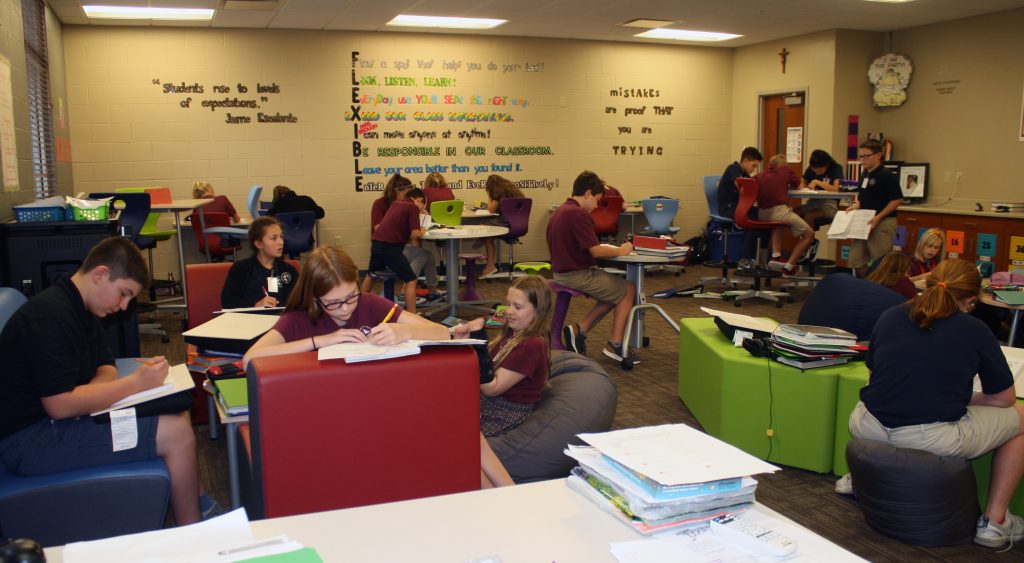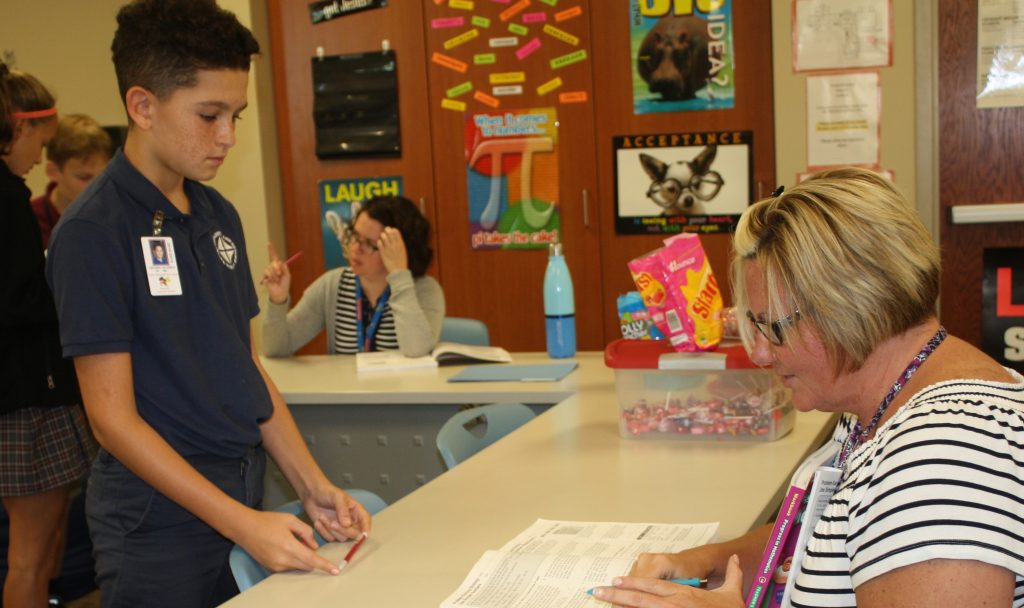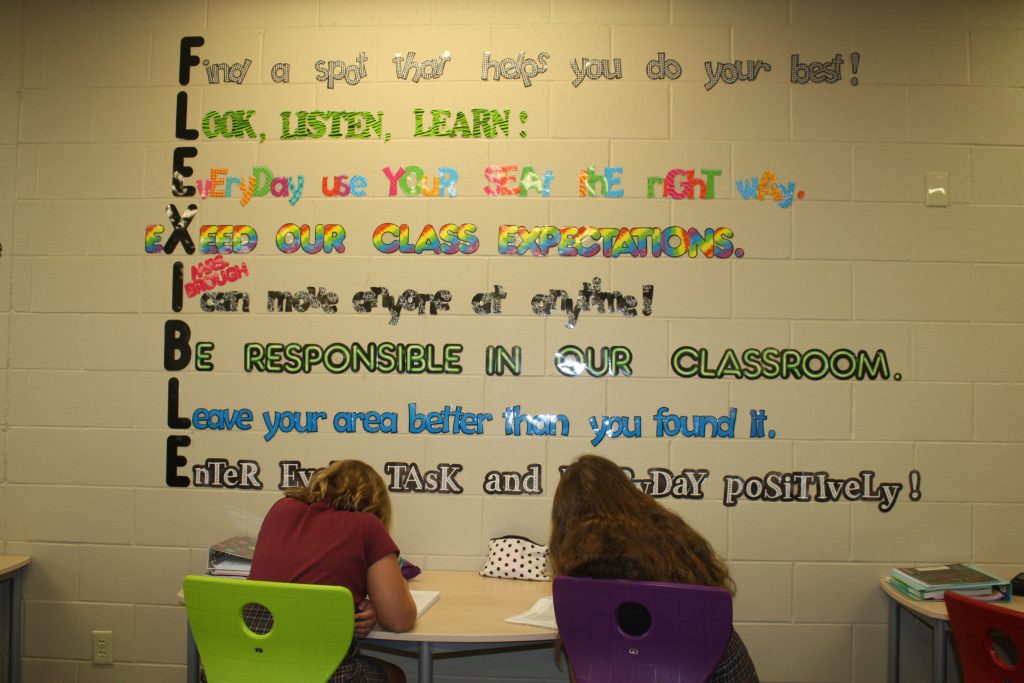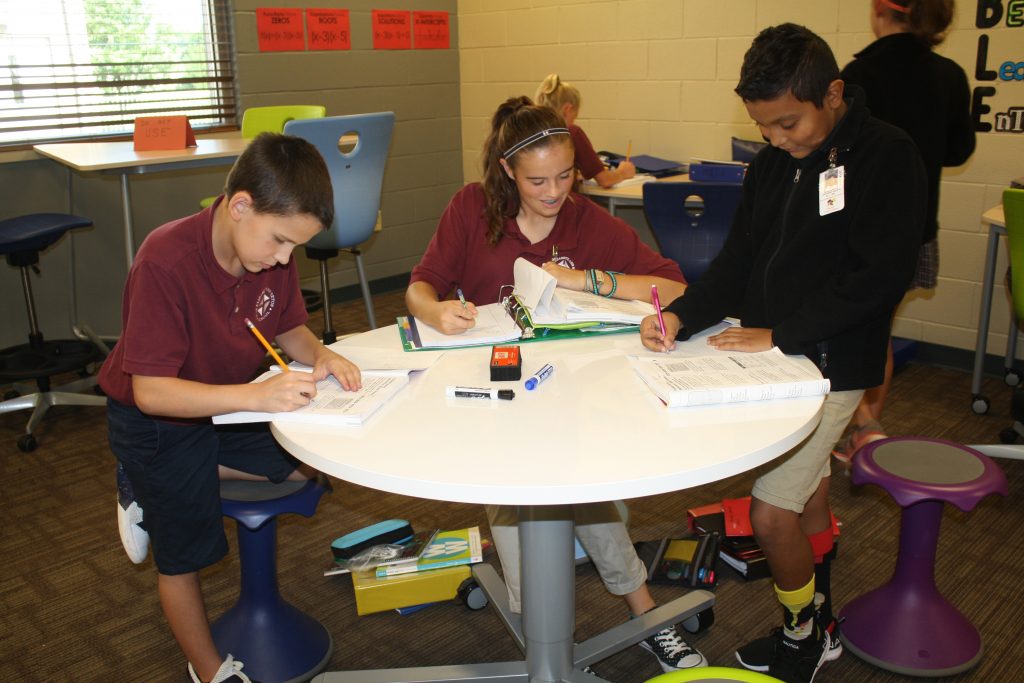October 5, 2018 // Schools
Teacher approaches school year with ‘flipped’ classroom
St. Elizabeth Ann Seton’s middle school mathematics teacher, Deb Brough, was looking for a better way to maximize her one-on-one time with each of her students. Her answer: a flipped classroom with flexible seating.
A flipped classroom switches around the traditional order of teaching. Students take notes at home, complete a short assessment while watching a video that Brough has created, then come to class and compete their homework and projects.
“The purpose of the flipped classroom is to create a more in-depth and supportive environment in the classroom where the teacher is present and able to help students,” said Brough.

The classroom of Deb Brough, math teacher at St. Elizabeth Ann Seton School in Fort Wayne, looks different due to the use of flexible work spaces. Even more unusual, however, is the process through which lessons are taught and reinforced for students. — Photos by Emily Diehm
For homework, St. Elizabeth middle school students are required to watch a video and complete a small assessment. Through the video, Brough teaches students the lesson and gives examples in the same way that they would receive content in the classroom. A series of questions are embedded, requiring students to interact with material while learning the content. Because the lesson is online, students can pause, rewind, or re-watch portions of the video at any time.
Brough believes the approach of students taking notes at their own pace drives them to becoming more self-directed.
“Having to know when they need to go back over a certain concept they did not fully grasp the first time allows the opportunity for students to take responsibility for their own education,” she said.

Sixth-grade St. Elizabeth Ann Seton School student Zach Calderon works on his math homework with teacher Deb Brough. “Mrs. Brough is very helpful and understands math. Her videos cut down on homework stress,” said Calderon.
Each lesson is specifically designed to have students view a video, take notes and reflect on the material by completing an assessment. This should take an average of 30 minutes or less. According to Brough, this is the same amount of time that a normal math assignment in a traditional setting could take.
A flipped classroom does not change the fact that students are expected to go home and do homework. The only thing that is different is the type of “homework” that they are doing. Students are expected to come prepared to class each day with the background knowledge of each concept, ready to dive deeper into the material.
“The flipped classroom requires students to take responsibility for their learning in several ways,” said Brough. Students must plan time to watch the video when they are still fully awake and able to make connections between content. They must take initiative to re-watch videos they need to see again.
Students must also make sure that if they are absent, they still watch the required videos and come to class prepared.
“My students are expected to take initiative in their learning. They know they can communicate with me either through email or in person if there are any issues with watching the videos,” said Brough, “There is an understanding that they should not wait until class time to discuss technology issues.”
 The flipped classroom has provided a means for the teacher to reach every student at the level they are at in regard to material and standards addressed.
The flipped classroom has provided a means for the teacher to reach every student at the level they are at in regard to material and standards addressed.
“I wanted continue to find a way to work for and with all of my students,” said Brough. “I especially wanted face time to listen to the kids speak math to me. When they don’t understand something, I’m here to work through it with them.”
She believes that her classroom challenges those that need to think further, while also support those who are struggling. A flipped classroom eliminates student frustrations at home, increases student engagement and increases student-teacher interaction.
“I wanted to be the one helping to guide my students past their challenges, roadblocks, and confusion. By flipping my classroom, I see less anxiety from my students. More students are coming into my room with an open mind to learn and challenge themselves. I love seeing the lightbulb go off — something I didn’t get to see when they did their homework at home.”
Along with a flipped classroom, Brough’s middle school math classroom offers students flexible seating., an option that allows for flexibility in classroom arrangement as well as in seating design. Brough has replaced the traditional classroom desks with a variety of tables, stools, couches, beanbag chairs, pillows and benches.
“Miss Widner brought the idea of flexible seating to me and I immediately jumped at the idea of continuing to be able to offer my students different ways to learn other than in a traditional setting,” said Brough. “Once it was proposed to me, my brain didn’t stop working on all the different possibilities and how to introduce the new seating arrangements to my students.”
 A study conducted by the University of Minnesota found that students participated 48 percent more in discussions in a classroom with collaborative group seating, versus traditional lecture-style seating, and improved their performance on standardized tests.
A study conducted by the University of Minnesota found that students participated 48 percent more in discussions in a classroom with collaborative group seating, versus traditional lecture-style seating, and improved their performance on standardized tests.
Brough feels that by creating more student control and less teacher control has improved student engagement. Her classroom is “truly a comfortable learning environment.”
Parents and students are excited about this teaching approach. The parents have told Brough they like seeing the videos at home because they get a glimpse of what their child is learning and how it is being taught. She, in turn, is excited about how well this school year is going and about the learning atmosphere of her classroom.
“I love seeing the students relaxed in their chosen spots and engaged while they work. The flipped classroom allows students to work independently at their own pace, conference with me multiple times a class period, and get immediate feedback on their progress,” she said. “I have seen their confidence increase while experiencing less anxiety over math. It’s been great!”
The best news. Delivered to your inbox.
Subscribe to our mailing list today.






